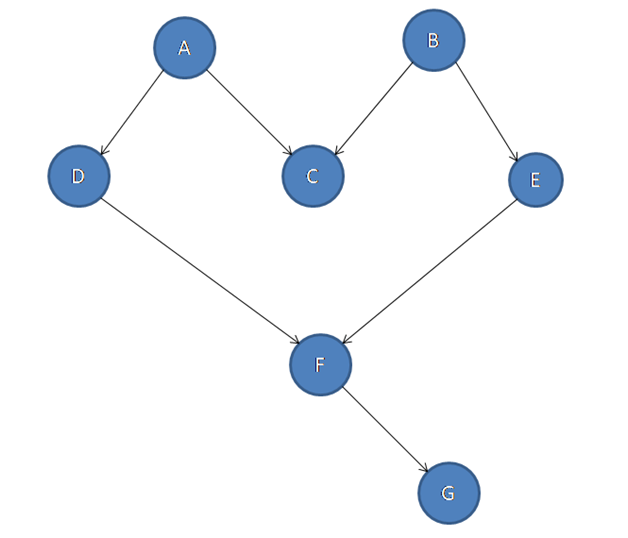Q:
Topological sort implementation using C++ program
belongs to collection: C++ programs on various topics
C++ programs on various topics
- C++ - Employee Management Program through Binary File Handling
- C++ program for flight booking system
- C++ program - Polymorphism implementation using Virtual functions.
- C++ program for Constructor and Destructor Declaration, Definition
- C++ Class Exercise - Read and Print Class, Students Details using Two Classes
- C++ Class Exercise - Read and Print House details along with Room details.
- C++ program to demonstrate example of Templates.
- C++ - Read Characters from One file and Write them in Toggle Case in Other using C++ file stream.
- C++ program to write and read time in/from binary file using fstream
- C++ program to write and read an object in/from a binary file
- C++ program to print the size of different types of pointers along with values and addresses
- C++ - Print the string character by character using pointer
- C++ program to declare, read and print dynamic integer array
- C++ program to declare an integer variable dynamically and print its memory address
- C++ - Initialization of Array of Objects with Parameterized Constructor in C++ program.
- C++ - program for Nested Structure (Structure with in Structure).
- C++ - program for Array of Structure.
- C++ program to demonstrate calling of private member functions inside public member function.
- C++ program to demonstrate use of protected data members in inheritance.
- C++ program to demonstrate calling of private member functions inside public member function.
- C++ program to demonstrate use of protected data members in inheritance.
- C++ program to access public data member inside main using object name.
- C++ program to declare, define and access public static data member.
- C++ program to print ASCII value of a character.
- C++ program to print the maximum possible time using six of nine given single digits
- Print Reverse Triangle Bridge Pattern for Characters in C++
- Sort an array in ascending order using sort() function in C++ STL
- Sort an array in descending order using sort() function in C++ STL
- Binary Search in C++ using Standard Template Library (STL) function binary_search()
- Stack program using C++ Standard Template Library (STL)
- C++ program to find the integers which come odd number of times in an array
- Vectors in C++ Standard Template Library (STL)
- C++ program to Find Nth element of the X-OR sequence
- Implementations of FCFS scheduling algorithm using C++
- Implementation of Shortest Job First (SJF) Non-Preemptive CPU scheduling algorithm using C++
- Implementation of Shortest Job First (SJF) Preemptive CPU scheduling algorithm using C++
- Implementation of Priority Scheduling (Pre-emptive) algorithm using C++
- Implementation of Priority scheduling (Non Pre-emptive) algorithm using C++
- Implementation of Round Robin CPU Scheduling algorithm using C++
- Jump Search Implementation using C++
- How to check if a number is power of 2 or not in C++ (different methods)?
- Print character through ASCII value using cout in C++
- C++ program to find and print first uppercase character of a string
- C++ program to declare, read and print dynamic integer array
- Count the created objects using static member function in C++
- C++ program to print the size of different types of pointers along with values and addresses
- C++ program to declare an integer variable dynamically and print its memory address
- new and delete operators in C++ with printing values through constructor and destructor
- C++ program to generate random password
- C++ program to print all possible subset of a set
- C++ program to print all possible subset of a set
- Find total Number of bits required to represent a number in binary in C++
- Find next and previous power of two of a given number in C++
- Create an object of a class inside another class declaration in C++
- Example of private member function in C++
- Local Class with Example in C++
- Structure with private members in C++
- Const Member Functions in C++
- Demonstrate Example of public data members in C++
- Dynamic Initialization of Objects in C++
- Create a class Point having X and Y Axis with getter and setter functions in C++
- Passing an object to a Non-Member function in C++
- Set values of data members using default, parameterized and copy constructor in C++
- Accessing Member Function by pointer in C++
- Access the address of an object using \'this\' pointer in C++
- Create a class with public data members only in C++
- Sum of all the elements in an array divisible by a given number K
- Find the roots of quadratic equation in C++
- C++ program to find Sum of cubes of first N Even numbers
- Sorting a structure in C++
- C++ program to multiply two numbers without using multiplication operator
- C++ program to find LCM of two numbers
- C++ program Input list of candidates and find winner of the Election based on received votes
- C++ program of Airline Seat Reservation Problem
- C++ program to Convert Roman Number to Integer Number
- C++ program to find presence of a number X in the array recursively
- C++ program to print all subsequences of a String
- C++ program to find number of BSTs with N nodes (Catalan numbers)
- C++ program to find first occurrence of a Number Using Recursion in an array
- C++ program to find Last occurrence of a Number using Recursion in an array
- C++ program to obtain Multiplication recursively
- C++ program to check whether a given Binary Search Tree is balanced or not?
- Append Last N Nodes to First in the Linked List using C++ program
- Eliminate duplicates from Linked List using C++ program
- Find a Node in Linked List using C++ program
- Merge sort for single linked lists
- C++ program to find Union of two single Linked Lists
- Find intersection of two linked lists using C++ program
- Representing System of Linear Equations using Matrix
- iswlower() function in C++
- iswupper() function in C++
- C++ program to print the left Rotation of the array
- C++ program to check if number is power of 2 using Bitwise operator
- Implement Stack using Linked List in C++
- Delete the middle node of a Linked List in C++
- Delete keys in a Linked list using C++ program
- Reverse a Linked List in groups of given size using C++ program
- Pair wise swap elements in a linked list using C++ program
- Convert a given binary Tree to Doubly Linked List (DLL)
- Modify contents of Linked List using C++ program
- Delete N nodes after M nodes of a linked list using C++ program
- Clone a linked list with next and random pointer using C++ program
- Topological sort implementation using C++ program
- C++ program to determine the color of chess square
- C++ program to find the power of a number using loop
- C++ program to extract and print digits in reverse order of a number
- C++ program to print all Even and Odd numbers from 1 to N
- C++ | Create class methods
- C++ | Create multiple objects of a class
- C++ | Create an object of a class and access class attributes
- C++ program | Different ways to print array elements
- C++ template program with arrays
- C++ | Define a class method outside the class definition
- C++ | Assign values to the private data members without using constructor
- C++ | Create an empty class (a class without data members and member functions)
- C++ | Create a class with setter and getter methods
- C++ tellg(), seekg() and seekp() Example
- C++ program for Banking Management System using Class





 C++ programming
C++ programming
Algorithm:
To solve this problem we follow this process:
C++ implementation:
Output